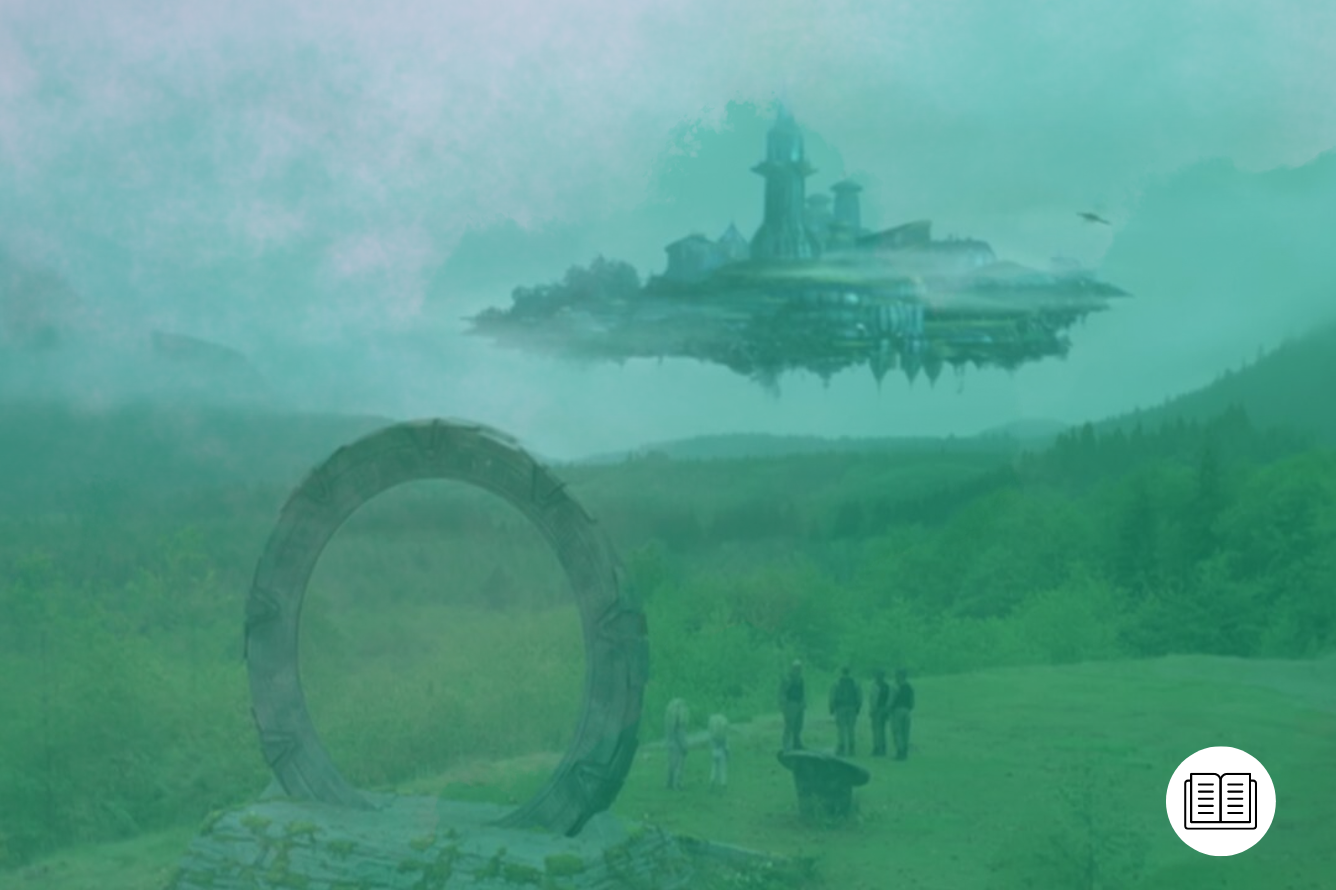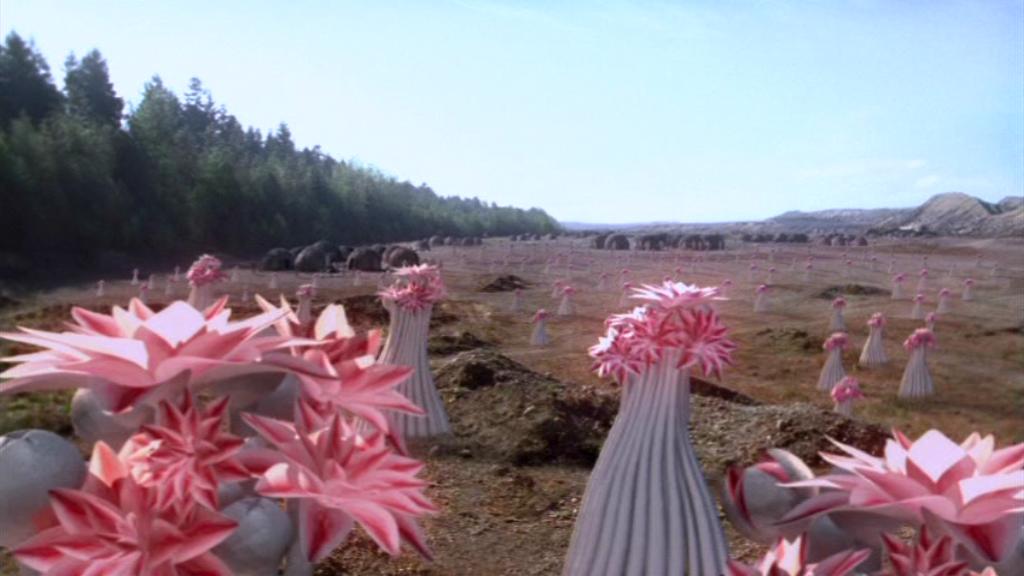The Stargate SG-1 episode ‘One False Step’ (S2, Ep19) is a more complex episode than it may seem at first. As much a thought experiment as an adventure on one of the odder planets SG-1 visits, it certainly makes for a memorable episode.
When a UAV is sent to PJ2-445, it becomes uncontrollable and crashes into a tall plant about 10 miles from the gate. before hitting the ground. Seconds later a humanoid alien steps into the view of the camera, proving that the planet is inhabited.
The SG-1 team goes to the planet to retrieve the UAV and make contact with this new alien race. What they find are humanoid aliens wearing a type of body paint as clothes. The aliens do not speak at all but make a type of high-pitched sound when they need to warn each other. They can also do a type of “throat singing” as a community.

However, soon some of the aliens fall ill and the team realizes that they may have brought a pathogen with them that is making the aliens sick. Dr. Janet Fraiser (Teryl Rothery) and part of the medical team come to PJ2445 to run tests and take one of the aliens back to the base to see whether they can find some kind of cure.

The team also starts succumbing to some type of illness and returns to the base. However, when they arrive on Earth, they feel healthy again. When Dr. Jackson (Michael Shanks) starts to fall ill again after watching some of the videos that he took on the planet they realize that there is a sound that humans normally can’t hear that is causing the symptoms.
The sound originates from the fungus-like plant. However, once the correct sound is played, the alien at the base becomes well almost immediately. Using equipment emitting the correct sound, all the aliens are returned to health. They start singing and the plant they have a symbiotic relationship with starts to bloom.
Mycelium Networks on Earth vs the Network in ‘One False Step’
Mycelium is a fine, branching, root-like fungus structure that absorbs nutrients from its environment. While it’s the food source of a number of soil invertebrates, mycelium is vital to almost all species of plants – in fact, some species co-evolve with fungi. Mycelium’s “fruiting bodies” are the mushrooms that are seen above ground. Mycelium range in size from colonies that are too small to see with the naked eye, to the largest living organism on the planet, the so-called “Humongous Fungus”; an Armillaria ostoyae, that covers some 2,385 acres of the Malheur National Forest in the USA.
These multicellular filaments link “nearly every tree in a forest – even trees of different species. Carbon, water, nutrients, alarm signals, and hormones can pass from tree to tree through these subterranean circuits” (‘The Social Life of Forests’, New York Times).
The plant network on PJ2-445 shows some similarities to the mycelium networks on Earth. When Teal’c (Christopher Judge) removes some of the soil between two of the plants, we find out that they are connected, much like a mycelium network. This is why, when the plant is injured by the UAV, the whole organism gives the wrong sound that then makes the aliens ill. This is why not only those in the village that we visit during the episode’s aliens get ill.

It can therefore be assumed that the organism on PJ2-445 stretches throughout the plain where the villages are. It’s unclear why the villages are built in specific places, but one could imagine that the clusters of huts are either built where the clusters of plants are above ground or that the plant grows above ground where the villages are.

The Question of Plant Consciousness
The matter of what constitutes consciousness, what makes a society “evolved”, and what sets humans apart from the rest of nature are also studied in the Stargate SG-1 episode ‘One False Step’.
The question of whether plants (or fungi, for that matter) are conscious organisms, has both its proponents and detractors in the scientific community. In the paper ‘Debunking a Myth: Plant Consciousness‘ by Mallatt, et al (2020), the authors conclude that “claims for plant consciousness are highly speculative and lack sound scientific support”. (Well, lucky for us, Stargate SG-1 loves things that are “highly speculative”!)
The book The Secret Life of Plants by Peter Tompkins and Christopher Bird – originally published in 1973 – held the hypothesis that, instead of being mere automata, plants “have now been found to be able to distinguish between sounds inaudible to the human ear and color wavelengths such as infrared and ultraviolet invisible to the human eye; they are especially sensitive to X-rays and to the high frequency of television.” Raoul Francé, an early 20th-century botanist and microbiologist, noted in his work that humans are trapped in an anthropocentric view of the world that is revealed through the five human senses and that humans can’t know all the events and phenomena that plants are constantly recording and observing.
Susan W. Simard’s work on the interconnectedness of trees (for instance in this 1997 article in Nature which may even have helped shape the Stargate SG-1 episode ‘One False Step’) did not hold a lot of water with many scientists at first. The New York Times notes in the article ‘The Social Life of Forests’ that Simard’s “metaphor and reverie … makes some scientists uncomfortable.” That she has spoken about her spiritual connection to the forest also makes some scientists very uncomfortable as it implies that the forest – or at least the trees within them – are in some form conscious, sentient beings.

Plant Consciousness vs Awareness
In Anthony Trewavas’ 2021 paper ‘Awareness and Integrated Information Theory Identify Plant Meristems as Sites of Conscious Activity’ (Protoplasma), he argues that “the mechanisms of animal assessment are neural while molecular and electrical in plants.” He also notes that controversy (like that expressed by Mallatt) over the consciousness of plants can be done away with by focusing on “awareness” in plants being their consciousness. Indeed, we need not see only the type of human consciousness that we ourselves experience as the only valid type of consciousness – a point that the episode makes very well.
Although speech is usually seen as one of the things that set humans apart, the alien race on PJ2-445 doesn’t seem to have a language in the way we would think of it. Yet they do communicate through their singing and body language. In this episode, we are forced to look at our own prejudices as to what it means to be an “evolved civilization”, and what it means to be human or alien.

Daniel: You know, I thought the alien on the video looked fairly docile. More curious than harmful.
Jack: I thought it looked bald, white, and naked.
Teal’c: Since this is their planet, is it not we who are the aliens?
And
Daniel: Well, I have to admit this is one of the stranger cultures that I’ve ever seen. As far as I can tell they’re communal, but there’s very little sign of actual social communication…
Jack: So… they’re a little less evolved than we are?
Daniel: Well, we don’t want to jump to any conclusions – remember the Nox?

Plant Movement and Interaction
Getting back to the plants themselves, the interaction between the alien plants and aliens also shows how intertwined their species are. For example, the plants rise from the ground with certain cues from the aliens and also start to bloom when the aliens sing a specific note/song.
The rapid movements of the alien plants are akin to that which is shown by certain “Earth plants” like the sensitive plant (mimosa pudica), venus flytraps, and the dancing plant (Codariocalyx motorius). Of course, having the alien plants move at “Earth plant speed” – definitely the scientific term for it – would be too slow for a 40-minute episode! The idea of plants moving fast enough for the eye to see is therefore not quite as alien as you might at first think.
What does set the alien plants apart is that they seem to move and bloom with the help of the aliens of PJ2-445. We don’t see the flowers of the plants until health is restored to the aliens at the end of the episode and they sing at a specific pitch. The plants all then rise from the ground and start to bloom – which leaves one ready to imagine how the rest of the earth-like fauna and flora of PJ2-445 interact with these plants. For example, which insects or animals eat the plants? Quite the worldbuilding paradise!
Plant Bioacoustics
The first time I can recall reading about the possibility of plants communicating through sound that lies outside of the scope of human hearing was in the story ‘The Sound Machine’ (originally published in The New Yorker, 1949) by Roald Dahl. However, the idea of plants making sounds is being actively studied in a scientific manner, with some very interesting findings.
For example, in the 2019 paper, ‘Plants Emit Informative Airborne Sounds Under Stress‘ by Itzhak Khait, et al, initial experiments on tomato and tobacco plants showed that stressed plants “emit airborne sounds that can be recorded remotely, both in acoustic chambers and in greenhouses”. These ultrasonic sounds (~65 dB SPL), recorded 10cm (4”) from the tomato and tobacco plants, imply that some organisms may be able to detect the sounds “up to several meters away.”
It must be added that there is also some skepticism of the paper’s findings by various scholars, mostly on the subject of using more controls. Edward Farmer of the University of Lausanne also notes that some of the ideas noted in the paper concerning the impact that these sounds may have on other organisms – like insects and animals – are a “little too speculative.”

Plant Music
Falling further into the plant sounds rabbit hole, you’ll come across plant music and, in the case of Plant FM, ambient plant music. This is not to say that plants are making music, per se, but that the biological signals from plants can (with the help of some software and skill) be turned into MIDI notes. These notes mimic various musical instruments and it is this music that you actually hear, not the biological processes themselves. The result is a quite otherworldly combination of notes and harmonies, at once strange yet inviting.
‘One False Step’ as a Warning (to Humans)
The episode is also a warning for human expansion into alien worlds – even if that world is right here on Earth, for example, in the depths of the ocean or rainforest. It is a warning not to plunge headlong into places of which you have limited knowledge and where “one false step” can easily have a catastrophic knock-on effect.
Although many false steps have been taken by humans over the centuries, this episode is an invitation not only to do what’s necessary to set things right but also a warning not to make the same mistake twice.
It’s been over 20 years since this episode of Stargate SG-1 first aired on TV, and it’s still as relevant as ever. Whether it’s confronting your own ideas of what civilization and culture mean to keep from destroying the very world that sustains us, ‘One False Step’ shows just what’s great about sci-fi that investigates the larger questions of humanity and our place in the universe – without preaching about it.
This article was first published on May 3rd, 2022, on the original Companion website.
The cost of your membership has allowed us to mentor new writers and allowed us to reflect the diversity of voices within fandom. None of this is possible without you. Thank you. 🙂











